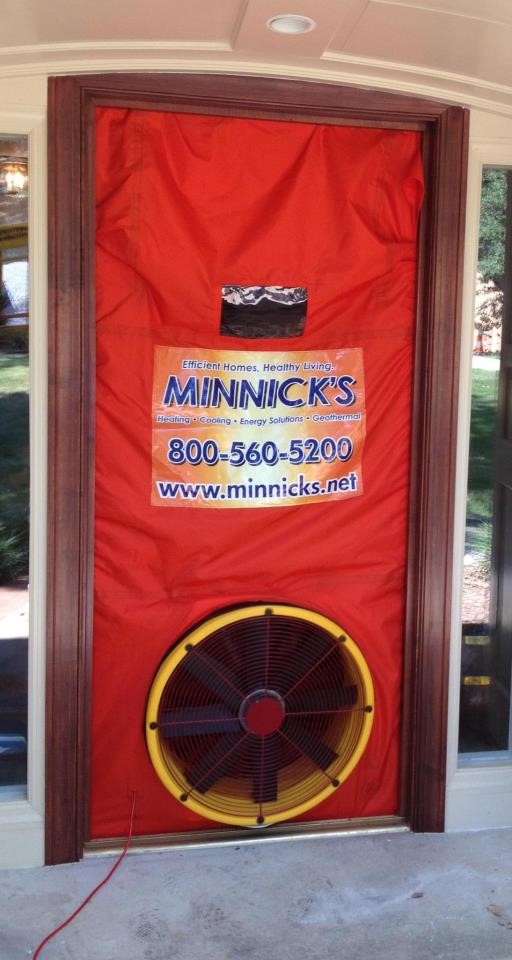An HVAC contractor called in to solve a comfort problem will usually first address the equipment. Some stop there, but more progressive contractors then look at the ductwork. Finally, comes the insulation.
HVAC equipment exists within an ecosystem, and these last two items make up part of that. The HVAC equipment moves the air within the house, but that air travels in and out of the structure on its own. That’s why it’s crucial to look at the whole picture, said David Richardson, director of technical curriculum and instructor at the National Comfort Institute.
“You can’t fix the comfort problem if you ignore the building,” Richardson said.
The same is true for energy issues. An HVAC system will run more in a poorly insulated building. This means higher energy costs.
To address these issues, an HVAC contractor needs to know what is really happening in a building, how the air is moving through it. The best way to do that is by conducting tests using specialized equipment.
Blower Door Test
The key test is a blower door test. The HVAC contractor places a plastic barrier at an entry door to a house, usually the front door. The contractor then uses a 22-inch 2,000-cfm fan to depressurize the house. Once the interior reaches 50 cfm, a device calculates how much air is leaked.

CREATING CONDITIONS: A blower door test includes a tarp or other plastic barrier installed at the main entryway to a house, which is usually the front door. (Courtesy of Minnick’s HVAC, Plumbing, & Insulation)
“To me, as an HVAC contractor, I feel this is the most important (test),” said Rob Minnick, CEO of Minnick’s HVAC, Plumbing, & Insulation in Laurel, Maryland. “I f we could only do one test during an energy audit, this would be the one.”
Minnick conduct Building Performance Institute energy audits for consumers. This includes grading the insulation in order to create an R value. The results of Minnick’s audits are entered into software from the local utilities, which then make some adjustments for their own programs.
All HVAC systems are designed based on how leaky a house is supposed to be. All houses leak to a degree, which allows fresh air into them. The problem is, the design and reality often fail to match up.
“In our area, I haven’t seen many houses that are leaking the standard,” Minnick said.
Real Life Conditions
Heat also comes in and out in ways it should not. The R value of Insulation is calculated in a laboratory, Richardson said. That means a perfect environment with any air movement or moisture. It’s also assumed that the insulation will be properly installed to begin with. As a result, insulation in a wall cavity is valued at R13, but only operates at R6. An infrared camera shows these areas where insulation is lacking, Richardson said.
“The blower door creates the air movement and the infrared allows you to visualize what’s going on with that air movement,” he said.
This data proves very valuable to the HVAC contractor. To the homeowner, it has less meaning. Minnick supplies them with the results of the blower door test, but it mostly confuses them. They really just want the bottom line on what they need to do to solve their problems.
There are additional tests HVAC contractors can conduct that show air movement. Some use a smoke blower, for example. Minnick said he’ll consider requests for these kind of tests, but doesn’t recommend them.
“If you want all that, I can get it, but I don’t know if you need it,” he said.
Know What the Results Mean
Richardson said most of these other tests are overkill. He said they turn an HVAC project into a science project. It’s better to become an expert with the blower door and the infrared camera. Richardson admits that wasn’t the case for him when he first started offering these tests.
“It wasn’t a very confidence instilling event for the first customers,” he said.
The best approach is to practice using the blower door equipment and the infrared cameras. Know exactly what the results mean and don’t try to make the measures mean more than they do. These tests each serve one really well-defined purpose, Richardson said.
The blower door test measures air movement. The infrared camera shows where there are thermal bypasses. This sounds simple, but the results are crucial in addressing the needs of homeowners.
“They play a very valuable role in what we’re trying to do when it comes to the comfort, health, safety, and energy-efficiency of a home,” Richardson said.



Report Abusive Comment